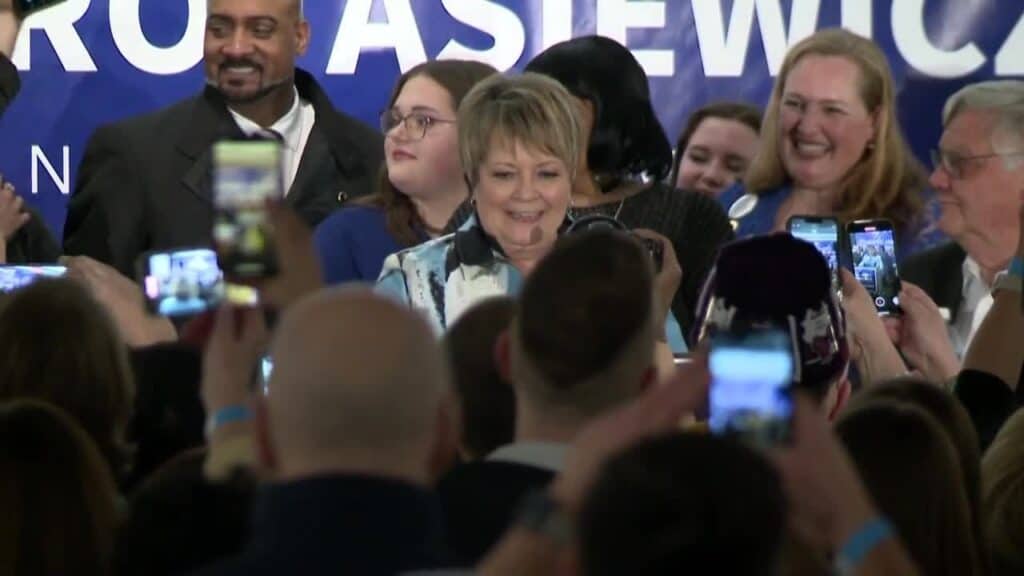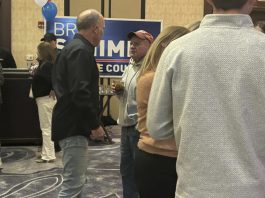These 9 things should enrage every Wisconsinsite.
To fully appreciate how outrageous and nakedly partisan the Wisconsin Supreme Court’s 4-3 redistricting decision really is, you have to read all 230-plus pages of it. Since the court’s four liberal flip-flopping horsewomen dumped this judicial monstrosity right before Christmas, we’ve read it for you, so you don’t have to.
The decision is a mockery of justice, it obliterates precedent and long-standing tradition, and it is a blatant partisan power grab by a court that is supposed to be politically neutral. “This is good, old-fashioned power politics,” swing Justice Brian Hagedorn wrote in a stinging dissent.
Reminder: The state Constitution gives the Legislature, currently Republican controlled, the power to choose redistricting maps. Legislative maps are supposed to be redrawn every 10 years following the census, as they were in 2020, not every time another justice is elected with $10 million in partisan money (the amount the state Democratic Party funneled to elect liberal justice Janet Protasiewicz, who joined the majority.)
Brief background: The legislature did draw maps after the 2020 census, but Democratic Gov. Tony Evers vetoed them, so they ended up in the courts. A different majority (Hagedorn plus three liberals) then picked Evers’ maps, but the US Supreme Court invalidated them because of how they mishandled race. The Wisconsin court, then with a conservative majority, finally chose the legislature’s maps because they offered the least change, insulating the court from politics. However, a group of liberals filed a suit to overturn the maps yet again right after Protasiewicz was elected; she declared the maps “rigged,” telegraphing how she would rule on the campaign trail.
The entire Assembly and half of the Senate are up for election in 2024, and they will stand for election now with new maps that no one has drawn or seen yet.
“This is the super-legislature that was promised by this liberal majority,” Supreme Court Candidate and former Attorney General Brad Schimel, who is running against liberal Ann Walsh Bradley, said in a statement, accusing the majority of “judicial activism.”
Here are 9 outrageous things about the Wisconsin Supreme Court’s redistricting decision, which overturned legislative maps the court picked just last year.
1. Three liberal justices flip-flopped, suddenly finding a key provision unconstitutional that three of them had just found constitutional
The liberal court based its decision entirely on a new definition of “contiguous,” saying the definition used to create the legislative maps a year ago was now suddenly unconstitutional. But here’s the kicker: Three of the justices in the majority had said that definition was constitutional two years ago. In other words, liberal justices Ann Walsh Bradley, Rebecca Dallet and Jill Karofsky are rank hypocrites whose flip-flopping exposes that they had a predetermined outcome and were searching for a tactic.
Here’s what it all means in layperson’s terms. The liberal court just ruled that, to be constitutional, legislative districts must be contiguous, defining contiguity as meaning the pieces of the district must touch. For 50 years, legislative maps have included what are called “municipal islands,” which are little pieces of districts that don’t touch the rest of the district. This was upheld by state and federal court decisions over the years.
This isn’t a big deal because the municipal islands are just pieces of land that municipalities have annexed, and almost no people live in them (0 to 20 in many). In other words, contiguity has been defined for decades as including these little pieces of annexed, often uninhabited land, if they are in the same municipality. This doesn’t cause harm to voters because the voters in the municipal islands are part of the same municipality as everyone else in their district, anyway.
However, just last year, when the liberal justices plus one conservative initially chose Gov. Evers’ maps, they were fine with municipal islands. Liberals Ann Walsh Bradley, Rebecca Dallet and Jill Karofsky believed them to be constitutional, then. Now they don’t. Nothing’s changed except they now have a liberal majority with Protasiewicz involved. The flip-flop exposes the naked partisanship.
Why were they constitutional then but unconstitutional now? They never explain.

Why did they settle on contiguity for their attack on the legislature’s maps? They needed to ground their Christmas massacre decision on something in the state Constitution because they’re trying to prevent the U.S. Supreme Court from being able to review their decision. That’s what we mean by hunting for a tactic to fit a predetermined outcome. But that’s not how an ethical judiciary is supposed to work.
2. They picked a radical fix that wasn’t necessary
Even if you accept that municipal islands are supposedly now unconstitutional when they weren’t a short time ago, for no clear reason, the liberal justices could have just dissolved the municipal islands into their surrounding assembly districts.
They could have just ordered new maps in districts that included them.
But they didn’t. They are ordering new maps for all legislative districts. This will be very disruptive to voters, and it exposes their partisan goals.
3. Gov. Evers flip-flopped on municipal islands too
Because so few people live in the municipal islands, the plaintiffs have a “standing” problem. In other words, the Wisconsinites who sued to get the legislative maps overturned don’t have standing because they aren’t directly harmed because they don’t live in municipal islands.
As Hagedorn wrote, “Given that almost all of the challenged municipal islands have a population smaller than the roster of the Milwaukee Brewers, and that the citizens living in them are kept in the same district as the rest of their municipality, this alleged harm might charitably be called a head-scratcher.”
To get around this, the liberals on the court said that, well, Gov. Evers has standing.
However, Evers flip-flopped on the contiguity question too. According to the court decision, Evers (and Senate Democrats and others) believed municipal islands were constitutional just two years ago when Evers submitted his own maps to the court which… contained municipal islands. And which the three liberals and Hagedorn initially picked.
In an appallingly hypocritical statement on the Christmas legal massacre, Evers said, “I agree with the Court’s determination that these maps are unconstitutional because the districts lack contiguity.”
So, is the governor saying that he put forth unconstitutional maps the last time around? What?
Hagedorn summed up the governor’s flip-flopping in his dissent, writing,
“The Governor’s legal positions throughout this redistricting litigation saga are astonishing; any other litigant in any other lawsuit would be promptly dismissed from the case. In Johnson, the Governor initially argued that the constitution’s contiguity requirement mandated physical contiguity, just like the petitioners argue in this case.
Then, the Governor changed course and agreed with all the other parties that keeping municipalities together did not violate the contiguity requirement…The Governor then submitted proposed remedial maps with municipal islands——the very thing the Governor now argues violates the constitution!
And in briefing regarding the other map proposals, which also contained municipal islands, the Governor never questioned their legality——even though he was invited to address any and all legal deficiencies in those proposals. Yet the Governor now tells us that our judicial remedy violates the constitution’s contiguity requirement.”
4. Any other litigant wouldn’t have been heard at all on what is called a “collateral attack” against a decided decision
Normally, litigants who have lost a case are not allowed to bring the same case on the same set of facts and make different (or the same) arguments than they made the first time around. This is called a “collateral attack” on a previous court decision.
And that’s what Evers, the only person granted standing, did.
As Hagedorn noted, “Were this case about almost any other legal matter, the answer would be cut-and-dried. We would unanimously dismiss the case and reject this impermissible collateral attack on a prior, final decision.”
He noted, “Under claim preclusion, and other equitable bars, the Governor cannot litigate contiguity again and should be dismissed from the case. And it’s not a close call.”
Claim preclusion prevents exactly this revolving door of court decisions being overturned and passed every time there is a new justice, destroying the integrity and political neutrality of the court.
In addition, the court disregarded a legal doctrine known as “stare decisis,” in which courts respect previous decisions. Chief Justice Annette Ziegler defined stare decisis in her dissent as a “legal principle” that demands a “respect for prior decisions.” Liberals constantly highlight the need for stare decisis when it comes to decisions they don’t like.
5. The court says it will consider “partisan impact” when drawing the maps but hasn’t defined a metric
The nakedly partisan liberals on the court outright state that they will consider “partisan impact” when drawing the maps (which they will get to do because Evers will veto whatever Republicans choose).
That means the judiciary is going to use politics as a guide. But the Constitution gave that power to the Legislature, not the Supreme Court. Historically, the court had opted for a “least change” measurement; the justices picked the maps with the least change. That kept the court isolated from the political decisions that are the domain of the Legislature.
In its Christmas decision, the liberal court threw out the least change doctrine in favor of “partisan impact.” But the liberal justices defined no metric for doing that. How will it be measured? No one knows. Will it include third parties? Will it take into account the fact that Wisconsin’s Legislature ends up Republican controlled because Republicans are more spread out throughout the state, whereas Democrats are mostly clustered in Dane and Milwaukee Counties?
What most people think the court will do is “pizza pie” Madison, creating multiple new districts in Dane County that will tilt Democratic, and will also pit Republican incumbents against each other in newly drawn districts elsewhere to get rid of people they personally dislike, such as Assembly Speaker Robin Vos.
But again this is not the role of the judiciary, and it’s why people correctly call this an activist court.
6. The deciding justice wildly prejudged the case on the campaign trail

In addition to taking $10 million from the state Democratic Party, which wanted the maps tossed, liberal Justice Janet Protasiewicz took a position on the Legislature’s maps on the campaign trail. Judges are not supposed to prejudge cases.
“The outcome in this case was preordained with the April 2023 election of a candidate who ran on a platform of ‘taking a fresh look’ at the ‘rigged’ maps,” wrote dissenting justice Rebecca Bradley.
In addition, Protaseiwicz’s top campaign strategist has been a leading liberal figure in efforts to get rid of the Republican legislative maps for years. And he has ties to people and groups involved in the current case. The US Supreme Court has been asked to rule on Protasiewicz’s bias.
7. Two unelected “consultants” from other states will now draw the maps
This is 1 of the unelected “consultants” who will be redrawing Wisconsin’s maps instead of Wisconsin’s elected Legislature pic.twitter.com/gONtuuZTvX
— Wisconsin Right Now (@wisconsin_now) December 23, 2023
Two professors from other states are going to draw the maps for the court. Thus, Wisconsin’s maps will be determined by two unelected consultants handpicked by four liberal justices, not by the elected Legislature which, again, is given the power to redistrict by the state’s Constitution.
It’s also not clear what parameters they will use or what guardrails exist on them.
“What of the fact that the citizens of Wisconsin and the litigants are forced, by judicial fiat, to have out-of-state, not stipulated to, unreviewable ‘consultants’ who are seemingly unaccountable to anyone but the court of four. In fact, the idea of hiring ‘consultant map drawers’ was sprung on counsel at oral arguments,” Chief Justice Annette Ziegler wrote in her dissent.
8. Evers is rejecting the Republican maps without seeing them
In his statement, Evers also made it clear that he believed the Republican Legislature’s new maps will be unfair before they have even been produced.
The court had asked the Legislature to draw new maps (knowing of course that Evers would veto them). But he isn’t even PRETENDING.
He is outright saying he will reject whatever the Legislature comes up with and submit his own maps, despite the state Constitution giving redistricting authority to the Legislature. This is an intrusion on the checks-and-balance system and an affront to voters who elected a Republican-controlled Legislature.
9. The case was fast-tracked as the result of another power grab
The liberals controlling the court really wanted to make sure the maps were rigged by them before the 2024 election. To make sure this happened, they seized the chief justice’s authority over court scheduling for themselves.
“This case was set to be fast-tracked and skip to the front of the line,” Chief Justice Annette Ziegler wrote in her dissent. “For nearly four decades and five chief justices, every member of the court had respected the power the people of Wisconsin constitutionally vested in the chief justice to administrate the court system.”
But not this court.
As Hagedorn concluded,
“The majority’s outcome-focused decision-making in this case will delight many. A whole cottage industry of lawyers, academics, and public policy groups searching for some way to police partisan gerrymandering will celebrate. My colleagues will be saluted by the media, honored by the professoriate, and cheered by political activists. But after the merriment subsides, the sober reality will set in.
Without legislative resolution, Wisconsin Supreme Court races will be a perpetual contest between political forces in search of political power, who now know that four members of this court have assumed the authority to bestow it. A court that has long been accused of partisanship will now be enmeshed in it, with no end in sight. Rather than keep our role in redistricting narrow and circumspect, the majority seizes vast new powers for itself.”
Table of Contents







![WATCH: Elon Musk Town Hall Rally in Green Bay [FULL Video]](https://www.wisconsinrightnow.com/wp-content/uploads/2022/04/Elon_Musk_3018710552-265x198.jpg)



![The Great American Company [Up Against the Wall]](https://www.wisconsinrightnow.com/wp-content/uploads/2025/03/MixCollage-29-Mar-2025-09-08-PM-4504-265x198.jpg)
![The Wisconsin DOJ’s ‘Unlawful’ Lawman [WRN Voices] josh kaul](https://www.wisconsinrightnow.com/wp-content/uploads/2025/03/MixCollage-29-Mar-2025-08-48-PM-2468-265x198.jpg)